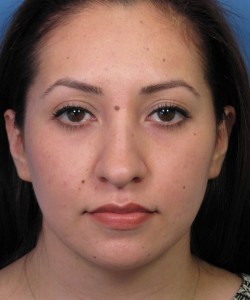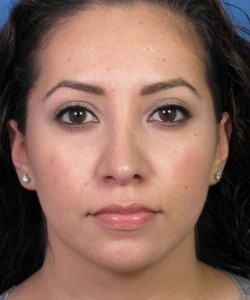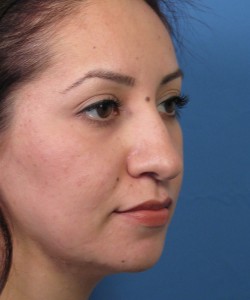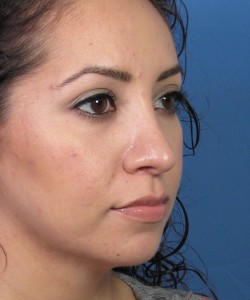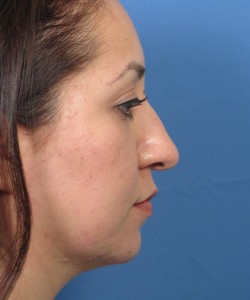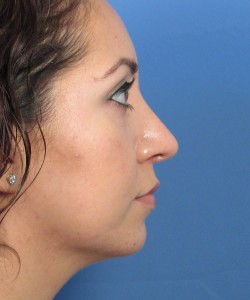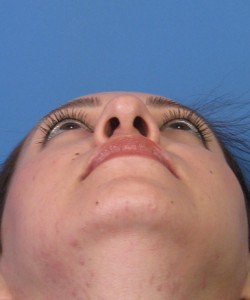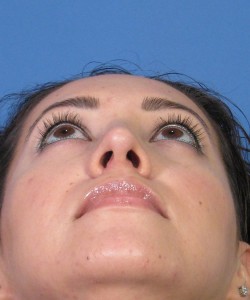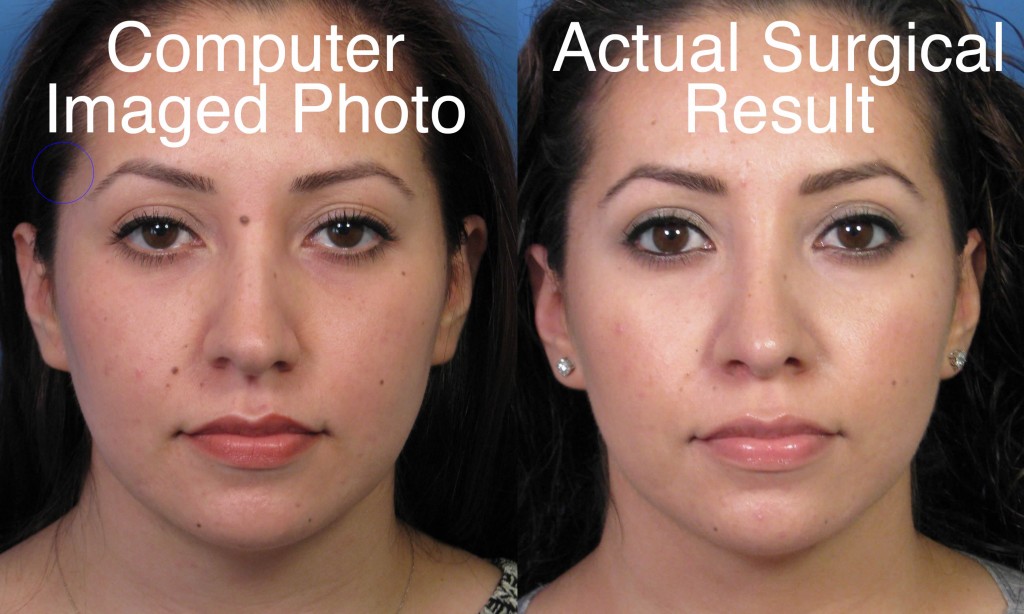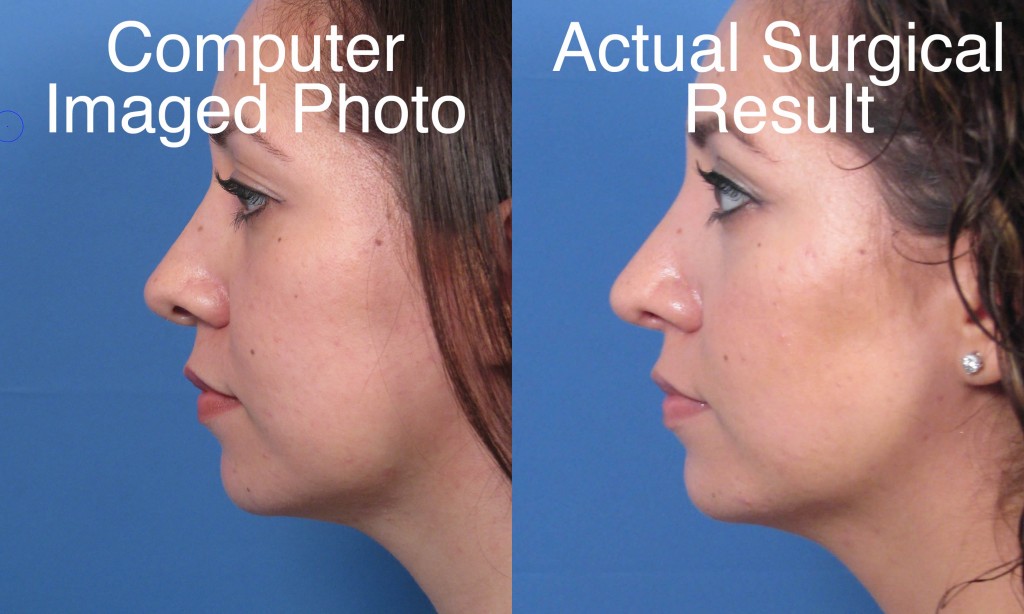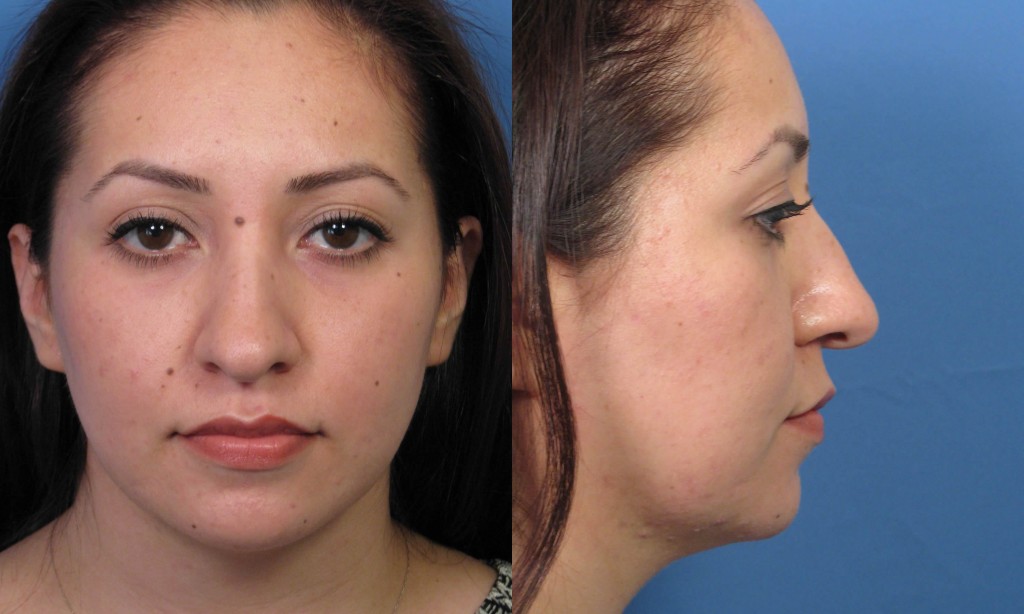 This is a great example of cosmetic nose surgery in an ethnic Hispanic rhinoplasty patient. This young lady came to my office desiring reshaping of her nose. Having a practice based relatively near the border of Mexico, I happen to see a large number of ethnic rhinoplasty patients who have Hispanic roots. Consequently, Hispanic cosmetic nose surgery has become a significant part of my ethnic rhinoplasty practice over the years. In this particular Hispanic rhinoplasty case example, the patient specifically desired to make her nose look smaller and more refined overall. In the process, she did not wish to have her Hispanic ethnicity erased – she simply wanted to address certain ethnic features of her nose that were bothering her. As you can see from her preoperative photos shown here, the nose was, indeed, disproportionally large for her surrounding facial features. This is a visual finding that is noted immediately on initial glance. When examined, her nose was found to have many of the other common features found in Hispanic rhinoplasty patients. For example, her nasal skin was assessed as being moderately thick and her nasal bridge showed a bump that was best seen on the side. In fact, she had what is termed a dorsal hump deformity – where the nasal bridge contour rises up to create somewhat of a convex shape when looking at the profile view. As in other Hispanic rhinoplasty patients, her nasal tip was considered poorly defined – almost appearing too wide on the frontal view. When looking at her nasal tip from the side view, it was found to be quite ptotic (pronounced tot-ii), or droopy. This is another common characteristic of Hispanic noses and often times a major compelling reason for seeking cosmetic ethnic nose reshaping surgery.
This is a great example of cosmetic nose surgery in an ethnic Hispanic rhinoplasty patient. This young lady came to my office desiring reshaping of her nose. Having a practice based relatively near the border of Mexico, I happen to see a large number of ethnic rhinoplasty patients who have Hispanic roots. Consequently, Hispanic cosmetic nose surgery has become a significant part of my ethnic rhinoplasty practice over the years. In this particular Hispanic rhinoplasty case example, the patient specifically desired to make her nose look smaller and more refined overall. In the process, she did not wish to have her Hispanic ethnicity erased – she simply wanted to address certain ethnic features of her nose that were bothering her. As you can see from her preoperative photos shown here, the nose was, indeed, disproportionally large for her surrounding facial features. This is a visual finding that is noted immediately on initial glance. When examined, her nose was found to have many of the other common features found in Hispanic rhinoplasty patients. For example, her nasal skin was assessed as being moderately thick and her nasal bridge showed a bump that was best seen on the side. In fact, she had what is termed a dorsal hump deformity – where the nasal bridge contour rises up to create somewhat of a convex shape when looking at the profile view. As in other Hispanic rhinoplasty patients, her nasal tip was considered poorly defined – almost appearing too wide on the frontal view. When looking at her nasal tip from the side view, it was found to be quite ptotic (pronounced tot-ii), or droopy. This is another common characteristic of Hispanic noses and often times a major compelling reason for seeking cosmetic ethnic nose reshaping surgery.
Hispanic Rhinoplasty Computer Imaging
During our rhinoplasty consultation, the patient and I reviewed her photos while performing computer imaging. This is a routine practice that I frequently employ to help the patient (and myself) better understand what type of cosmetic changes might be possible with the nasal reshaping process. Computer imaging involves morphing of the patient’s actual photographs to reshape the nose in demonstrating what type of surgical change might be accomplished. However, all patients must keep in mind that computer imaging like this is not an exact science – nor is it a guarantee/warranty of actual changes that might result from rhinoplasty. Rather, computer imaging should be viewed as just another tool to help the patient and surgeon understand what direction and degree of change is desired. 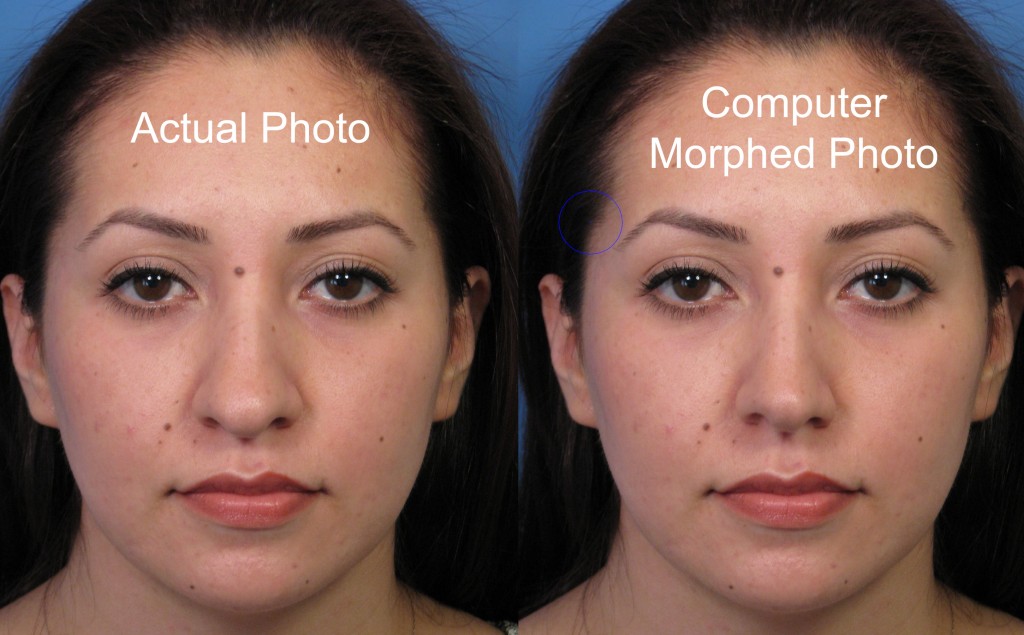 In this Hispanic rhinoplasty patient, the computer imaging is shown here. As you can see from the frontal images (shown to the left), I tried to show her how ethnic rhinoplasty surgery can help make the bridge look more narrow. At the same time, her nasal tip could be made to look more defined and narrowed. As part of this process, the nasal tip would need to be lifted up slightly to help address the ptotic tip issue.
In this Hispanic rhinoplasty patient, the computer imaging is shown here. As you can see from the frontal images (shown to the left), I tried to show her how ethnic rhinoplasty surgery can help make the bridge look more narrow. At the same time, her nasal tip could be made to look more defined and narrowed. As part of this process, the nasal tip would need to be lifted up slightly to help address the ptotic tip issue. 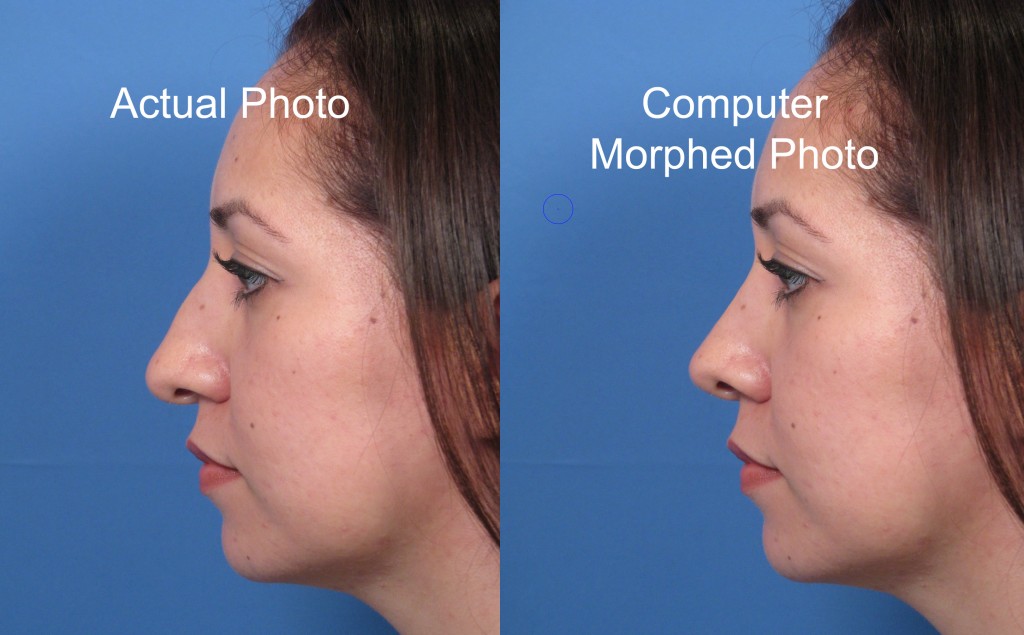
Computer imaging of her lateral photo is shown here as well. As you can see, I tried to show her what it might look like if the nasal bridge height was reduced. In particular, I wanted to demonstrate how the bridge might look if it were straighter – not scooped – just straighter without the hump. With regard to the nasal tip, I morphed the photo to show how it might look with elevation and rotation of the nasal tip to try and create a more feminine tip position. Based partially on these morphed computer images (along with a thorough discussion of her case), the patient decided to proceed with the rhinoplasty surgery.
Hispanic Rhinoplasty Surgery
I ended up performing an open cosmetic rhinoplasty procedure to try and accomplish the type of changes seen in the computer morphed images above. The open rhinoplasty approach was necessary, in my opinion, so that optimal exposure of the nasal tip could be achieved. In cosmetic nose surgery cases like this, it is really important to have full visualization of the nasal tip region when trying to make more dramatic changes as was desired. 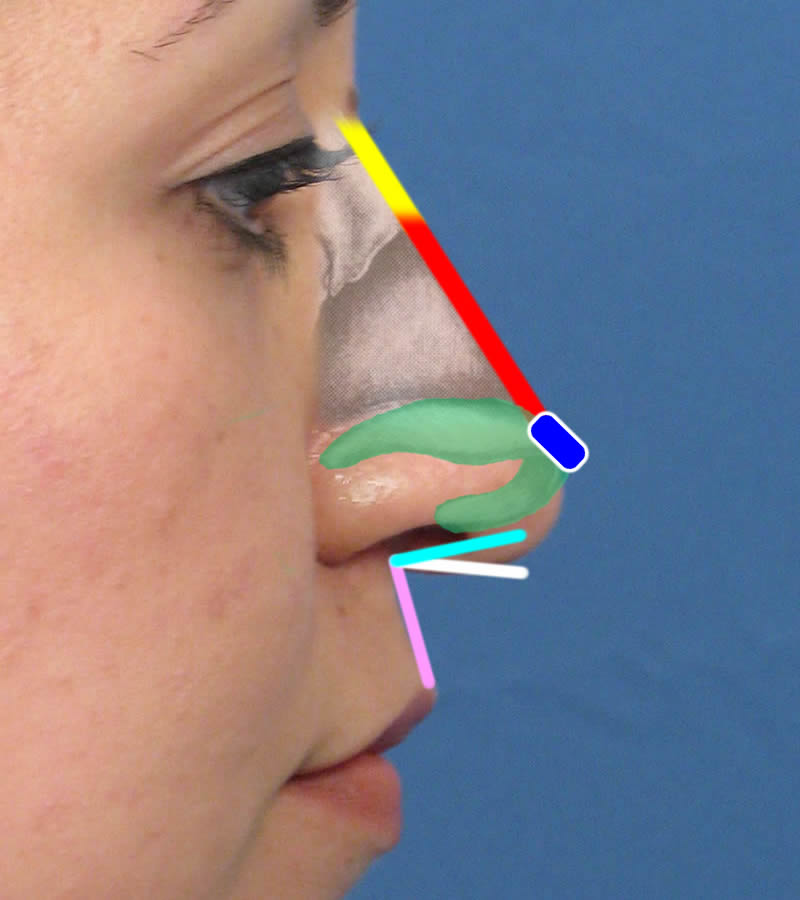 During the rhinoplasty surgery, the excess cartilage along the bridge was first trimmed down. This is shown in the adjacent diagram as indicated by the red line. The bony portion of the nasal bridge was then shaved down using a rasping technique (yellow line). Once this was accomplished the sides of the nasal bones were then cut so that they could be narrowed as seen from the frontal view. Her nasal tip was then completely taken apart as it was detached from the remainder of her nose. This allowed me to literally move her tip into a new position. The green shaded structure in the diagram is her lower lateral cartilage, which forms a majority of the nasal tip shape. Originally, her lower lateral cartilage was positioned much lower down toward her upper lip. This is indicated by the nasolabial angle formed between the pink and white lines (where the white line runs along the lower border of her old nasal tip). This old angle was less than 90 degrees. The ideal nasolabial angle in a female is closer to 95-105 degrees. Once her nasal tip was moved, the new nasolabial (formed by the pink and light blue lines) was considered much closer to ideal. Finally, the nasal tip was narrowed from the frontal view and given more definition with use of a cartilage graft (as indicated by the blue rectangle sitting atop the lower lateral cartilage).
During the rhinoplasty surgery, the excess cartilage along the bridge was first trimmed down. This is shown in the adjacent diagram as indicated by the red line. The bony portion of the nasal bridge was then shaved down using a rasping technique (yellow line). Once this was accomplished the sides of the nasal bones were then cut so that they could be narrowed as seen from the frontal view. Her nasal tip was then completely taken apart as it was detached from the remainder of her nose. This allowed me to literally move her tip into a new position. The green shaded structure in the diagram is her lower lateral cartilage, which forms a majority of the nasal tip shape. Originally, her lower lateral cartilage was positioned much lower down toward her upper lip. This is indicated by the nasolabial angle formed between the pink and white lines (where the white line runs along the lower border of her old nasal tip). This old angle was less than 90 degrees. The ideal nasolabial angle in a female is closer to 95-105 degrees. Once her nasal tip was moved, the new nasolabial (formed by the pink and light blue lines) was considered much closer to ideal. Finally, the nasal tip was narrowed from the frontal view and given more definition with use of a cartilage graft (as indicated by the blue rectangle sitting atop the lower lateral cartilage).
Hispanic Rhinoplasty Results
The actual results of this Hispanic patient’s rhinoplasty are shown here. Overall, you can tell at initial glance that her nose is now much more proportional in terms of size. It is also much more defined as seen from the frontal view. Just look at the comparison of her nasal tip width before and after rhinoplasty. Through this type of Hispanic rhinoplasty surgery, the entire nasal tip region has been made to be more triangular in shape, which produces the appearance of a more narrow, refined nasal tip. The bridge has also been narrowed as seen from the front. The improvements made to the nasal tip position are best seen from the oblique and side views as shown below. As you compare her before and after photos, see for yourself how changes to the lower lateral cartilage translate into a more elegant looking nasal tip. Combine this with reduction of the bridge height and removal of the dorsal hump deformity and you can really see a dramatic difference in the overall shape of her nose. But her nose still looks like it fits her face. There are no obvious signs of her having had a ‘nose job’ as they say. Her nose now appears as if she could have been born with it.
Computer Imaged Comparison
Looking back at her computer enhanced photos and comparing these to her actual surgical results reveals a fairly close approximation.
Hispanic Rhinoplasty Consultation
If you or someone you know is interested in undergoing Hispanic cosmetic rhinoplasty surgery, do not hesitate in contacting my office today to schedule a complimentary consultation to review your options. As one of the most well-trained rhinoplasty experts in this region, I can offer you unparalleled experience with ethnic cosmetic rhinoplasty surgery.

